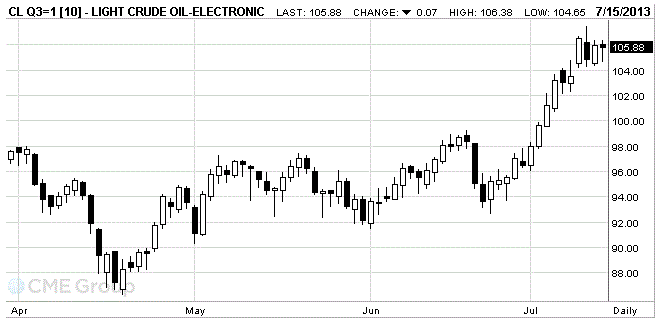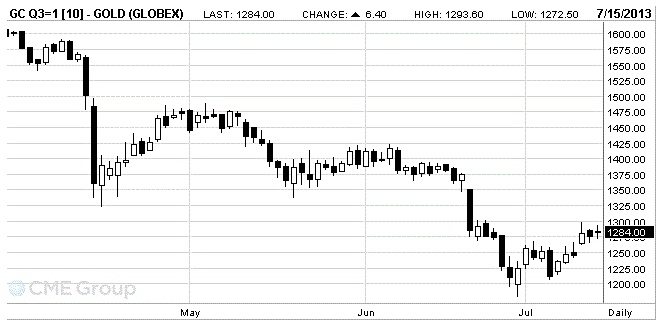Notícias do Mercado
-
16:41
Oil: an overview of the market situation
Oil prices fell slightly, dropping below $ 109, which was associated with the publication of Chinese data, which showed a slowdown in economic growth and a weaker-than-expected rise in retail sales.
According to data from the National Bureau of Statistics of China, the gross domestic product (GDP) of China in the II quarter of 2013 increased by 7.5% year on year. This figure is the lowest since 1999. The official estimate for economic growth in April-June was below analysts' expectations - at 7.7%. We also add that China's GDP in the II quarter of 2013 compared to the previous quarter fell 0.2%. In the previous quarter (January-March 2013) GDP growth at an annual rate of 7.7%.
In the first half of 2013, China's GDP reached 24.8 trillion yuan (4.04 trillion U.S. dollars) - a 7.6 percent increase over the same period in 2012.
In a separate report, the statistical office showed that industrial production rose by 8.9 percent year on year in June. It was weaker than the 9.2 percent rise in May and the projected 9.1 percent expansion.
Investment in fixed assets grew by 20.1 percent in January-June, slower than the 20.4 percent growth between January and May, another report showed the Statistical Office. It was also lower than expected growth of 20.2 percent.
The data added evidence that China's economy is facing downward pressure from sluggish external demand and economic restructuring.
The authorities have recently stated that they are willing to endure the economic slowdown and go ahead with more ambitious economic reforms in order to achieve sustainable and balanced growth in the long term.
However, some data showed that retail sales growth was better than expected. Sales increased by 13.3 percent year on year in June, faster than the 12.9 percent growth forecast. In May, sales rose by 12.9 percent.
We also note that the dynamics of trades also had an impact statement by OPEC. The Organization of Petroleum Exporting Countries said the possibility of reducing the volume of oil production at 500,000 barrels a day in December, if that happens, it would be the first decline in five years. The forecast is based on the assumption that the increase in production of oil shale deposits in the U.S. will lead to a reduction in demand for oil cartel in 2014. According to the expectations of OPEC and the International Energy Agency in 2014, the demand for OPEC oil will be lower than the current 30 million barrels per day.
It is predicted that in the first half of 2014, oil demand will be about 800,000 barrels per day less than 30 million barrels a day now.
The decision to limit production decreases in the cartel will depend on the level of world oil reserves in December. Risks, given the political crisis in Egypt and floods in Canada may induce the cartel to refrain from lowering the limit of production. OPEC will not cut production if oil prices remain above $ 100.
The cost of the August futures on U.S. light crude oil WTI (Light Sweet Crude Oil) fell to 105.88 dollars a barrel on the New York Mercantile Exchange.
August futures price for North Sea Brent crude oil mixture fell to $ 108.80 a barrel on the London exchange ICE Futures Europe.

-
16:20
Gold: an overview of the market situation
Gold prices recovered from lows, aided by the publication of weaker-than-expected data on U.S. retail sales, which may weaken the prospects for reducing stimulus measures from the Federal Reserve System.
Note that today's report showed that U.S. consumers spent more on gasoline and cars in June, but showed little interest in the other goods, which raises concern that personal spending will cause a leisurely recovery.
Total retail sales increased by 0.4% last month to a seasonally adjusted $ 422.79 billion, the Commerce Department said Monday. But excluding autos and gasoline retail sales were down 0.1%.
The overall increase was below the forecast of economists had expected growth of 0.7%. Retail sales and food sales rose 5.7% from a year earlier.
U.S. retail sales are growing steadily, despite the depth of the economic crisis. Consumer spending accounts for over two-thirds of the total demand in the U.S.
Sales of auto dealers rose 1.8%, continuing a strong picture of this year's sales, which grew by more than 11% year on year. But excluding the automotive sector retail sales were unchanged. The volume of retail sales, which exclude gasoline, autos and building materials - the value for the closely-watched economists who use it as a true gauge of consumer behavior - was 0.15% higher.
Recall that gold had reached nearly three-week high after Fed Chairman Ben Bernanke said last week that a highly adaptive policy will be needed for the foreseeable future, which indicates that will be supported by low interest rates, and increase the attractiveness of gold. But in spite of this, many experts still expect the Fed will begin to slow down the pace of asset purchases by the end of the year.
Meanwhile, today it was announced last week that gold stocks in the largest exchange-traded fund ETF SPDR Gold Trust fell by 2.6%, showing the biggest weekly decline since late April. This year, the stock has decreased by more than 13 million ounces, or $ 17 billion at current prices.
The cost of the August gold futures on COMEX today rose to a high of $ 1284.00 an ounce.

-